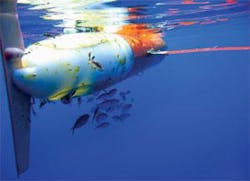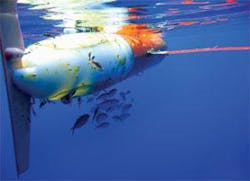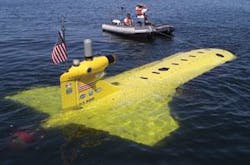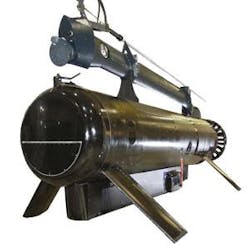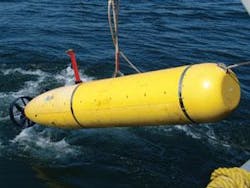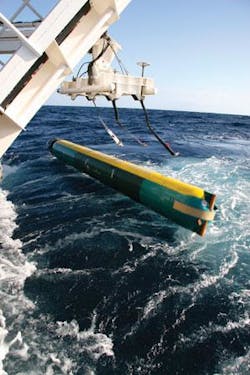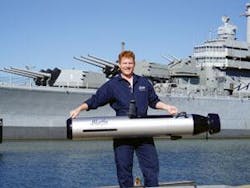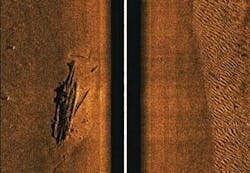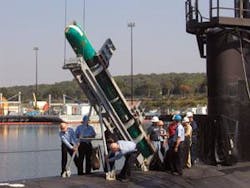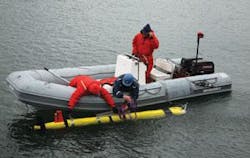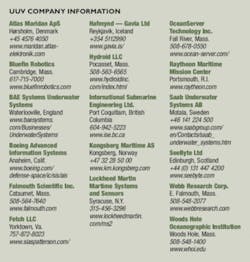Swimming robots
Navy experts and industry leaders are looking into the latest generation of unmanned underwater vehicles (UUVs) for maritime applications ranging from training and mission rehearsal, undersea surveys and surveillance, and locating and destroying enemy mines, to potentially even covertly deploying weapons.
By John Keller
For the past three decades U.S. Navy experts have relied on unmanned undersea vehicles (UUVs), first as programmable targets to train anti-submarine warfare (ASW) crews on surface ships, and later as remote sensing platforms. Today the Navy is increasing its use of UUVs for counter-mine warfare, and is beginning to use autonomous undersea vehicles to map the ocean floors, locate submerged wrecks and obstacles, and occasionally to find and photograph underwater archeological sites.
In the future, advances in machine intelligence, closed-system propulsion, long-life rechargeable batteries, digital data storage, through-water communications, and rugged-environment embedded digital signal processing promise a era in UUV applications, which are expected to include surveillance and reconnaissance; relocatable covert communications and networking nodes; electronic warfare; anti-submarine tracking; and perhaps even weapons delivery.
The world’s oceans continue to be increasingly dangerous places, so military and commercial maritime interests will keep looking to autonomous watercraft to keep humans out of harm’s way in the unforgiving environment of the sea.
The need for UUVs
The Navy and global maritime industries, such as offshore oil exploration and production, have long had a need for unmanned underwater vehicles. It is only recently, however, that UUV technology has been advanced sufficiently for a broad variety of applications. The need for UUVs is driven primarily by safety. The more UUVs are put into operation, the fewer humans will be required to work in dangerous underwater environments, wearing diving gear or in manned submarines.
Sheer numbers also enter the equation. On the military side, large numbers of UUVs have the potential not only to replace humans in dangerous jobs, but also to augment the jobs they replace. One case in point: the U.S. has a limited supply of manned attack submarines to patrol economic and political hot spots throughout the world, yet large numbers of UUVs have the potential to keep an eye on important places in the ocean, and to work together with the manned submarine crews.
Consider the offshore oil industry, which often faces dangerous operating conditions in increasingly deep and dangerous coastal waters. Robotic underwater vehicles could help this industry save money and keep workers safe by remotely inspecting and maintaining pipelines, assisting in drilling, and cleaning up any debris. Offshore oil drilling and production rigs of the future also may be submerged so as to free the pristine coastal vista of ugly offshore rigs. On such a structure, UUVs would be increasingly valuable for inspection and maintenance.
History
UUVs of one tycratepe or another have been in use since the 1970s anti-submarine warfare training. The latest modification (mod-2) of the Lockheed Martin MK 30 tactical UUV is a heavy torpedo-sized vehicle designed to simulate the movements, sounds, and magnetic signatures of a variety of submarines to enable ASW ships and aircraft to detect, track, and even fire non-exploding weapons at the MK 30 to hone their skills.
The MK 30 UUV target, which can be launched by submarine, ship, or aircraft, has limited autonomy and limited reaction to ASW tactics, explains Daniel French, head of the autonomous undersea vehicles division at the U.S. Naval Undersea Warfare Center (NUWC) in Newport, R.I. Nevertheless, compared to UUV prototypes and even some deployed systems, the MK 30 capabilities are somewhat primitive. “Targets are specific-purpose vehicles,” French says.
NUWC is the U.S. Navy’s center of excellence for unmanned underwater vehicles. The center maintains an engineering staff able to design and test UUV concepts, as well as contracting and technology experts who supervise and evaluate UUV development, experiments, and testing at defense contractors. NUWC reports to U.S. Naval Sea Systems Command in Washington.
UUV prototype development over the few years has embraced many platform shapes and sizes, which have come with advances in UUV enabling technologies like software for vehicle autonomy, batteries and propulsion, sensors, and fast signal processing. The large Manta UUV was developed at NUWC as a demonstration platform for autonomous technologies, and from time to time has been considered for roles like persistent surveillance and weapons delivery.
The vehicle is big—more than 34 feet long, weighing about 30 tons. It has 21-inch pressure hulls, and can accommodate 5,000 pounds of payload in its hull and atop its sail, which looks like the tail of a jetliner. Over time, Manta has been envisioned as simply a modular test bed for system demonstration, as well as a weapons-carrying mothership capable of deploying torpedoes, cruise missiles, or smaller UUVs.
If the Navy ever had serious plans for the Manta in an operational role, those plans have since been put on hold. “She’s really just a hangar queen now,” says Christopher Egan, UUV customer advocate at NUWC. Manta has not been in the water for quite some time, and stored at NUWC. The large vehicle could always be dusted off later if Navy officials would like to resurrect experiments with large UUVs.
Navy scientists also have been experimenting with the Solar Autonomous Undersea Vehicle, otherwise known as SAUV, which is designed by Falmouth Scientific Inc. in Cataumet, Mass. NUWC experts use this solar-powered craft as a test bed for developing machine autonomy capability, and for experiments with long-endurance surveillances—especially when networking these vehicles and operating them as tag teams.
The SAUV can operate submerged for about five hours, but then must surface for five hours to recharge its batteries via an array of photovoltaic cells mounted on top of the vehicle. Networking these vehicles as tag teams might enable one charged vehicle to pick up where another left off when its batteries ran low and the vehicle surfaced for a recharge.
It’s no accident that American UUV development is centered in England. Much of the nation’s UUV technology development revolves around UUV research centers of excellence at the Massachusetts Institute of Technology (MIT) in Cambridge, Mass., and at the Woods Hole Oceanographic Institution in Woods Hole, Mass. NUWC is less than an hour or two’s drive from MIT and Woods Hole.
Enabling technologies
One of the difficulties of UUV development today is designing a vehicle with some level of machine autonomy. That means the vehicle must be able to adapt its actions to changing conditions, draw conclusions and make decisions based on information it picks up during missions, and must have an interrupt-driven architecture to enable the vehicle to change its direction, speed, tactics, and primary sensors if human operators give it an expected high-priority task during a mission.
Key enabling technologies for this kind of capability include software algorithms for vehicle autonomy; high-endurance batteries able to withstand the rigors and harsh environment of prolonged maritime operations; closed propulsion systems able to operate for long periods on little power and little, if any, access to oxygen; and fast, power-efficient embedded computing and digital signal processing to transform sensor data into useful, actionable information. “Batteries, sensors, and signal processing are our technology thrusts,” says NUWC’s French.
One important unmanned test vehicle at NUWC is MARV—short for mid-sized autonomous research vehicle—which is 16 1/2 feet long and just slightly more than one foot in diameter for testing different UUV programs and technologies. “Energy is one of our biggest thrusts,” French explains. “MARV can operate for 20 to 24 hours on one lithium ion (LiOn) battery charge.”
For some applications, 24 hours between battery charges might be enough, but Navy officials are not satisfied with that. “The Navy wants to operate for days, not hours,” French says. As a result, NUWC experts are investigating the use of long-endurance propulsion methods like burning metals and solid-oxide fuel cells. Ultimately, however, “I think the answer will be in batteries,” French says.
Although battery power for UUVs still has a long way to go, there was a time not long ago when batteries were show stoppers, not enablers, where autonomous underwater vehicles were concerned. “A lot of our technology in years past was geared around how to create a system that would go down by itself and survive,” says Christopher Wallsmith, chief technology officer at UUV designer Bluefin Robotics in Cambridge, Mass. “The energy systems at that point didn’t have any good solutions for rechargeable batteries. The technology was silver zinc, but could outgas hydrogen.”
Bluefin engineers have developed a pressure-tolerant rechargeable battery system, based on lithium polymer technology. “They don’t outgas when we recharge them,” Wallsmith says. “We might be able to pod them in a solid pack and not have to provide a mechanism for the gas to escape. You can put it in the wet part of the vehicle rather than in a pressurized compartment.”
Vehicle autonomy—or providing UUVs with some degree of intelligence—also is a major technological thrust in the undersea robot community. “The thing that enables autonomous underwater vehicles (AUVs) is autonomous software,” explains David Kelly, president and chief executive officer of Bluefin Robotics.
As UUV designers attempt to make their machines smart, however, they must consider several different levels of machine autonomy, which Kelly calls “layers of abstraction.” One level of autonomy, for example, might encompass the safe control and operation of the vehicle. Designers must program in machine behavior that might enable the vehicle to swim out from a launch vessel, dive, run a track-line survey of the ocean bottom and surrounding water columns, and then surface safely for recovery, Kelly explains.
“Another layer in the research and development realm is cooperation between vehicles,” Kelly says. “We have experiments where you have several vehicles operating simultaneously. Based on what one vehicle might find, the behaviors of the other vehicles would change.” Enabling several UUVs to work together might help operators cover broader search areas, and might help UUVs with different kinds of sensor packages to bring their best strengths to bear, he says.
Not all of the technology necessary to give UUVs autonomous capability is limited to the undersea community, explains NUWC’s French. “We work with the Jet Propulsion Laboratory, and the Mars Rover has similar autonomous behavior to what we use.”
Enabling a UUV to navigate without intervention from a human operator is a technological challenge closely related to vehicle autonomy. “We have had a challenge with the accuracy of underwater navigation without GPS [the satellite Global Positioning System] or something similar,” Wallsmith says. “We have developed high-accuracy underwater navigation with a compass and Doppler velocity log, and with some GPS correction when you come to the surface.”
Embedded computing and fast signal processing also is a driving technology for UUV development. One of the primary reasons for this is the difficulty of sending large amounts of data over wireless links through the water; through-water bandwidth is miniscule compared to what is possible through the air. As a result, UUV designers must be extremely careful about what they plan to send over data links—unless they intend to surface their vehicles, which can be dangerous.
Wireless links over the air have such broad bandwidth that systems designers easily can plan on sending raw sensor data from antenna to antenna. This is not possible with through-water data links. If UUVs cannot process data onboard, then often they must store the data and download it for processing after completing the mission and being recovered to surface ships or aircraft.
“There is a big demand to do on-board signal processing, and off-board a reliable piece of information,” says NUWC’s French. “We have no advantage of bandwidth in the UUV community. UUV bandwidth is limited by physics. We have a capacity of tens-to-low-hundreds of kilobits per second.” Technologies are being developed for high-bandwidth through-water communications with lasers, but even that approach would be limited by distance.
“A lot of the data from side-scan or synthetic aperture sonar is not processed on board today,” says Bluefin’s Kelly. “You could do it on board to reduce the data you need to store.” He points out, however, that for data-gathering tasks that are not time-sensitive, there is little need for extensive on-board signal processing. “If you need to change the mission, like for mine countermeasures, you need on-board processing,” he cautions.
“Better sensor processing on the vehicle means sonar processing and algorithms for making decisions based on that sonar data without a human operator in the loop or with little communications,” says Bluefin’s Wallsmith.
Applications
Near-term applications for generations of UUVs span a wide range, from intelligence, surveillance, and reconnaissance; mine countermeasures; anti-submarine warfare; inspection and identification; oceanography; communications and navigation network nodes; payload delivery; information operations; and time-critical strike, according to the Navy Unmanned Undersea Vehicle Master Plan.
Today’s primary use for UUVs is technology demonstration at research centers like NUWC, followed closely by maritime mine countermeasures and surveillance and intelligence gathering.
For technology demonstration and experiments, one of the most important UUVs at NUWC is 16 1/2-foot MARV, which demonstrates imaging sonar systems for UUVs. Famed oceanographer Robert Ballard—the man who found the wreck of the ocean liner Titanic—used MARV to explore underwater archeology sites off the coast of Virginia, says NUWC’s French.
MARV also helps Navy oceanographers make maps and images of the ocean floor to help future generations of UUVs navigate over long periods without the need to surface periodically to take a GPS fix. UUVs have inertial navigation systems, but typically experience drift of about five meters per hour. Accurate image databases of the ocean bottom could help future UUV navigation from visual fixes on the bottom.
Also developed at NUWC is the Advanced Development Unmanned Underwater Vehicle (ADUUV), which is made of titanium and is designed to accommodate a wide variety of modular sensor and communications payloads for different missions. Modular UUV payloads are expected to be applicable to several different vehicles. “You want to avoid the need to re-invest in the same kinds of payloads for different UUVs all the time,” says NUWC’s Egan.
NUWC’s REMUS 600 vehicle, short for remote Environmental Monitoring Units, designed by Woods Hole, also is for testing synthetic aperture sonar technology, which can map the ocean bottom covering large areas quickly with fine-resolution imaging.
Another NUWC UUV is the 21 UUV, which is the same size as a Navy MK 48 heavy torpedo. Navy experts are using this as a test bed for surveillance, reconnaissance, and electronic intelligence. The prototype UUV is fitted with a mast with RF and optical sensors, as well as a keel that lowers to keep the vehicle balanced when the sensor mast rises.
Counter-mine UUVs
Counter-mine warfare is another major thrust in UUVs. One of highest-profile systems is the AN/WLD-1 Remote Minehunting System (RMS)—a 23-foot semi autonomous, semi submersible vehicle that locates and classifies sea mines. The system’s manufacturer is the Lockheed Martin Undersea Systems division in Riviera Beach, Fla.
The RMS can function under control of a human operator or on its own. It is a small diesel-powered submarine with a snorkel and antenna mast that always sticks out of the water. The system’s mission is to detect and pinpoint mines in the water so that other systems can come back and destroy them later or so that Navy commanders can alter their missions to avoid minefields.
The AN/WLD-1 system can operate for the better part of a day, and is deployed aboard Arleigh Burke-class guided missile destroyers. It has an onboard camera to navigate and avoid obstacles, and uses the Raytheon AN/AQS-20 Minehunting Sonar System, which the AN/WLD-1 tows behind it at variable depths to locate mines.
Boeing Advanced Information Systems in Anaheim, Calif., builds the AN/BLQ-11 Long Term Mine Reconnaissance System (LMRS), a torpedo-sized UUV that is deployable from surface ships or from the torpedo tubes of the Navy’s Los Angeles- and Virginia-class fast attack submarines to survey potential mine fields.
Sonatech Inc. in Santa Barbara, Calif., builds the advanced forward-looking and side-looking mine detection and classification sonars, as well as the homing/docking and acoustic telemetry sonars for the AN/BLQ-11.
The Talisman UUV from BAE Systems Underwater Systems in Waterlooville, England, is designed to operate in coastal waters and harbors to perform mine countermeasures and oceanographic work. Communications to and from the vehicle are enabled via WiFi or Iridium satellite communications, and using an acoustic link when the vehicle is submerged. Battery power enables the Talisman to operate for as long as 24 hours.
Bluefin makes several kinds of UUVs, ranging from the Spray autonomous underwater glider to the Bluefin 21, a heavy torpedo-sized UUV. The Spray can glide up and down the water column by changing its displacement with a hydraulic pump. It can be used for environmental surveillance, and its developers envision a potential application to inspect the hulls and structures of piers for homeland-security applications.
Glider-type UUVs, which are designed to move slowly through the water, perform sharp maneuvers, and to hover in place even in heavy currents or turbulent seas, also have the potential for marine industrial applications, such as offshore oil exploration and production. Glider UUVs might be able to inspect underwater pipelines and structures and help with repair operations.
Boeing demonstrates AN/BLQ-11 UUV deployment and recovery from submarines
Officials of Boeing Advanced Information Systems in Anaheim, Calif., have demonstrated the autonomous launch and recovery of the AN/BLQ-11 Long Term Mine Reconnaissance System (LMRS) unmanned underwater vehicle (UUV) from the torpedo tubes of a submarine.
U.S. Navy experts plan to use the AN/BLQ-11 primarily for detecting and pinpointing submerged ocean mines in support of naval and amphibious military operations. The AN/BLQ-11 UUV is designed to be deployable from surface ships and submarines.
The first demonstration of deploying the AN/BLQ-11 from a U.S. Navy attack submarine occurred last November. Navy and Boeing officials are continuing development leading to wide deployment of the system.
Testing confirms that the unmanned vehicle can return to the submarine and be recovered by a robotic arm, Boeing officials say. During tests last November, the AN/BLQ-11 also made complex maneuvers, including station keeping and “shadow submarine” during which the system operates underwater alongside the host submarine.
